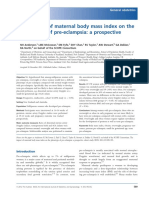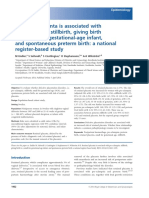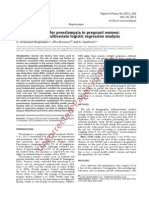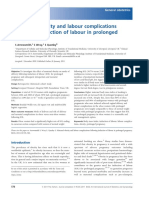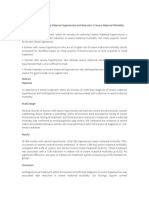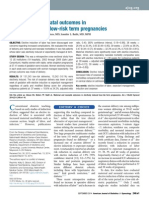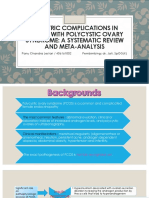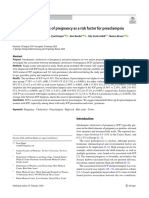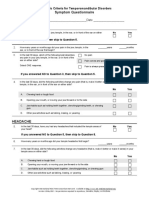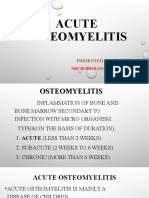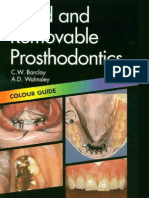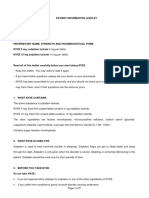Short Stature Is Associated With An Increased Risk of Caesarean Deliveries in Low Risk Population
Short Stature Is Associated With An Increased Risk of Caesarean Deliveries in Low Risk Population
Uploaded by
Manangioma ManCopyright:
Available Formats
Short Stature Is Associated With An Increased Risk of Caesarean Deliveries in Low Risk Population
Short Stature Is Associated With An Increased Risk of Caesarean Deliveries in Low Risk Population
Uploaded by
Manangioma ManOriginal Description:
Original Title
Copyright
Available Formats
Share this document
Did you find this document useful?
Is this content inappropriate?
Copyright:
Available Formats
Short Stature Is Associated With An Increased Risk of Caesarean Deliveries in Low Risk Population
Short Stature Is Associated With An Increased Risk of Caesarean Deliveries in Low Risk Population
Uploaded by
Manangioma ManCopyright:
Available Formats
ACTA MEDICA LITUANICA. 2007. VOLUME 14. No. 1. P.
16
Lietuvos moksl akademija, 2007 Maternal height and Caesarean section Lietuvos moksl akademijos leidykla, 2007
Short stature is associated with an increased risk of Caesarean deliveries in low risk population
Sylvia Kirchengast1, Beda Hartmann2
Institute for Anthropology, University of Vienna, Austria
1
Department of Gynecology and Obstetrics, Hospital of Neunkirchen, Austria
2
Objective. Maternal somatometric characteristics are clearly associated with pregnancy outcome, first of all newborn weight and length. The impact of maternal stature on birth and especially on the mode of delivery, however, is discussed controversially. This study examined the impact of maternal stature on the mode of delivery, in particular on the Caesarean section rate. Methods. In this prospective study, data of 4278 live births at the Viennese University Hospital were analyzed. Since preterm births, maternal age below twenty years, Caesarean delivery on request, breech or transverse presentation and coincident medical diseases such as diabetes mellitus or nephropathy, drug or alcohol abuse, twin birth or IVF were strict exclusion criteria, the study population can be described as a low risk population. Maternal anthropometrics (height, weight, weight gain) and newborn somatic characteristics (birth weight, birth length, head dimensions, APGAR scores) were documented. Binary logistic regression models were used to evaluate the risk factors for Caesarean delivery. Results. The Caesarean section rate was 17.7%. Beside newborn somatometric characteristics, such as head dimensions and birth weight, maternal stature was significantly associated with the rate of caesarean section. With decreasing maternal stature the risk of Caesarean sections increased significantly. Especially among short and very short women (<150 cm) the rate of Caesarean deliveries was extraordinarily high (>40%). According to binary regression analyses, maternal stature had a significant impact on the mode of delivery, while, in contrast, no significant associations between the mode of delivery and maternal age, prepregnancy weight status, pregnancy weight gain as well as pelvic dimensions were found. Conclusion. Short stature is significantly associated with the risk of Caesarean delivery. Key words: maternal height, infant anthropometrics, Caesarean deliveries
INTRODUCTION The relationship between maternal anthropometric characteristics, first of all maternal weight status and pregnancy weight gain, and pregnancy outcome is well known and has been documented by many authors (13). Especially short maternal stature was mentioned to be associated with adverse pregnancy outcome such as high rates of low birth weight newborns and low APGAR scores (4, 5). Furthermore, maternal height has been reported as an obstetric risk factor, since short maternal height may be associated with cephalo-pelvic disproportion (CPD) resulting in obstructed labor (57).
Correspondence to: Univ. Prof. Dr. Sylvia Kirchengast, Institute for Anthropology, University of Vienna, Althanstrasse 14, A-1090 Vienna, Austria. E-mail: sylvia.kirchengast@univie.ac.at
Therefore, short maternal stature seems to represent an important risk factor for emergency Caesarean section (8, 9). Steiner et al. (10) described short women, with a stature below 155 cm as high risk patients for Caesarean section even after controlling for labor dystocia. Witter et al. (6) showed that a maternal height less than 157 cm was significantly associated with an increased risk of Caesarean delivery. As the main causes for emergency, Caesarean section in short women, cephalo-pelvic disproportion (CPD) and labor arrest were mentioned (1117). Although as to be seen above a number of studies have reported a correlation between maternal height and the risk of Caesarean section, some authors failed to find any association between maternal height and the mode of delivery (18, 19). Therefore, the present study was aimed to investigate the relationship between maternal stature, pregnancy outcome and the mode of delivery in an
S. Kirchengast, B. Hartmann
Austrian sample. Since preterm births, a maternal age below twenty years, Caesarean delivery on request, breech or transverse presentation and coincident medical diseases such as diabetes mellitus or nephropathy, drug or alcohol abuse, twin birth or IVF were strict exclusion criteria, the study population can be described as a low risk population. MATERIALS AND METHODS Data set In the present study, data on 4278 births which took place at the University Clinic for Gynecology and Obstetrics in Vienna were analyzed. The data were collected prospectively and altogether the data of 7138 births were collected. In the analyses included were all births which occurred between the 39th and 41rst week of gestation, because only term births of comparable gestational length should be included in analyses. Exclusively nulliparous women ageing between 20 and 41 years whose first prenatal check took place during the eighth week of gestation were enrolled in the present study. Additionally the following inclusion criteria were used: all prenatal check-ups of the motherchild passport completed, the delivery of a single infant without congenital malformations, no registered maternal diseases before and during pregnancy, no hypertension (BP < 150/90 mmHg), no proteinuria, no glucosuria, no pregnancy-related immunization. Furthermore, maternal age below twenty years, Caesarean delivery on request, breech or transverse presentation and coincident medical diseases such as diabetes mellitus or preeclampsia, drug or alcohol abuse, twin birth or IVF were strict exclusion criteria. Therefore, only 4278 births were included in the final analysis. Gestational age was calculated in terms of the number of weeks from the beginning of the last menstrual bleeding to the date of delivery (= duration of amenorrhoea) and by two consecutive ultrasound examinations performed before the 12th week of gestation. All subjects were Caucasians of Austrian or Central European origin. The study was approved by the local bioethical committee. Anthropometric data The following anthropometric data were determined according to the methods described in Knussmann (20): Maternal anthropometrics Stature, prepregnancy weight (PPW), weight at the end of pregnancy (EPW), weight gain during pregnancy (PWG) were determined according to the methods described in Knussmann (20). Stature was determined at the first prenatal visit. Prepregnancy weight was estimated by means of the retrospective method and the first weight determination, which was carried out at the first prenatal visit (8th week of gestation). During the first 13 weeks of gestation a weight gain of only 1.7%
can be assumed. Therefore, combination of the retrospective method and weight determination at the 8th week of gestation seemed to be appropriate in the present study. To determine prepregnancy weight, the mean value of the retrospective estimated weight and the weight at the 8th week of gestation were calculated. Weight gain during pregnancy was calculated by subtraction of prepregnancy weight from body weight at the end of pregnancy. Maternal weight status before pregnancy was described as the body mass index (BMI) (kg/m2). Weight status was classified according to the WHO recommendations (21). Newborn anthropometrics The following parameters were taken directly from the newborn immediately after birth: birth weight, birth length, head circumference, diameter frontooccipitalis, acromial circumference. Birth weight was classified as very low <1500 g, low 15002500 g, normal 25004000 g and high (macrosomia) >4000 g. Also, the one- and five-minute APGAR scores for the evaluation of the newborn were determined. Obstetrical characteristics The mode of delivery, spontaneous versus Caesarean section, was documented as an indicator of severe obstetrical complications during birth, because Caesarean sections requested by the mother were excluded from the analysis and therefore only emergency Caesarean sections were included in the present sample. Statistical analysis Statistical analysis was performed by means of SPSS for Windows program Version 11.0. After calculating descriptive statistics (means, SDs), group differences were tested regarding their statistical significance using Students t tests. The analysis included the c2 for the linear trend. Additionally, odds ratios were calculated. Binary logistic regressions were computed in order to test the association among maternal stature, prepregnancy body mass as well as newborn anthropometrics and the mode of delivery. Spontaneous delivery was coded as 1 and Caesarean section as 2. RESULTS Mode of delivery Within the present sample, 758 (17.7%) Caesarean sections took place. The most frequent indications for Caesarean delivery were fetal distress (42.8%) and dystocia (37.5%). Maternal and newborn anthropometrics The maternal height distribution is presented in Fig. 1. As to be seen, only less than 10% were shorter than 155 cm. The mean height was 164.1cm (6.5). The
Maternal height and Caesarean section
prepregnancy weight status of the majority of women (77.0%) corresponded to the definitions of normal weight (BMI 18.524.99); 10.2% of the women exhibited underweight during prepregnancy phase, whereas overweight during prepregnancy phase was found among 13%, however, severe overweight (BMI > 30.00) was only described for 2.4% of the women. Since only term births were included in the present analysis, 92.6% of the newborns corresponded to the definitions of normal
weight (25004000 g), 1.6% were classified as low weight (<2500 g), and no birth weight below 1500 g was found; 5.8% of the newborns were classified as macrosomic (>4000 g). Neither maternal prepregnancy weight status nor newborn weight status were significantly associated with the mode of delivery (see Table 1). In contrast, among newborns with an APGAR score below 7 the percentage of Caesarean delivery was extremely high (Table 1).
Fig. 1. Maternal height distribution
Table 1. Maternal and newborn characteristics by mode of delivery, Students t tests and c2
Maternal height (cm) Prepregnancy weight (kg) Prepregnancy weight status (BMI) (kg/m2) Distantia spinarum (cm) Distantia cristarum (cm) Birth weight (g) Birth length (cm) Acromial circumference (cm) Head circumference (cm) Diameter frontooccipitalis (cm) Prepregnancy weight status <18.50 kg/m2 18.5024.99 kg/m2 25.0029.99 kg/m2 >30.00 kg/m2 Newborn weight status <1500 g 15002499 g 25003999 g >4000 g APGAR values < 7 APGAR 1 min (n = 210) APGAR 5 min (n = 34)
Caesarean delivery (n = 819) X (SD) 162.9 (7.1) 59.2(10.5) 22.19 (3.39) 24.8 (2.1) 27.9 (1.9) 3344.8 (435.1) 49.9 (1.9) 36.9 (2.4) 34.4 (1.3) 11.3 (0.7) 8.7% 75.7% 12.7% 2.9% 0.0% 2.0% 90.4% 7.6% 43.3% 38.2%
Vaginal delivery (n = 3820) X (SD) 164.3 (6.4) 59.9 (9.7) 21.75 (3.21) 24.8 (2.1) 28.0 (2.0) 3335.3 (399.3) 49.8 (1.8) 36.7 (2.2) 34.3 (1.4) 11.3 (08) 10.6% 77.0% 10.1% 2.3% 0.0% 1.5% 92.7% 5.8% 56.7% 61.8%
Significance <0.0001 n. s. <0.05 n. s. n. s. n. s. n. s. <0.05. <0.05 <0.05 n. s.
n. s.
<0.001 <0.001
S. Kirchengast, B. Hartmann
Maternal somatometrics and mode of delivery Caesarean delivery was associated with a significantly lower maternal height and a significantly higher prepregnancy body mass index (Table 1). As to be seen in Fig. 2, very short women (<145 cm) showed the significantly highest rate of Caesarean sections, while the lowest percentage of Caesarean sections was found among tall women (c2 = 63.6; p < 0.0001). With increasing maternal stature the relative risk of a Caesarean section decreased significantly (Table 2). An especially high risk of Caesarean section was found among very short women (<145 cm) in comparison to women of average height (>160 cm). The observed significant impact of maternal stature on the mode of delivery was corroborated by the results of a binary logistic regression analysis. Although all maternal anthropometric
parameters were included in the regression analysis, only maternal stature was significantly associated with Caesarean section (Table 3). Regarding newborn somatometrics, birth weight, birth length and acromial circumference were independently related with the mode of delivery (Table 3). DISCUSSION An impressive body of gynecological literature has shown that short maternal stature is frequently associated with a poor pregnancy outcome and obstetric complications often requiring emergency Caesarean sections (22, 23). Especially often the association between maternal stature height and the risk of emergency Caesarean section has been described since more than two decades by
Fig. 2. Maternal height and Caesarean delivery
Table 2. Relative risk of Caesarean delivery in comparison with maternal height >160 cm (odds ratio and 95% confidence interval)
Maternal height <145 cm 145149 cm 150154 cm 155160 cm
OR 6.18 4.20 2.78 1.38
95% confidence Interval 1.7921.29 2.716.51 2.183.58 1.181.61
Table 3. Binary logistic regression analysis (spontaneous = 1, section = 2)
Variable Maternal height Prepregancy BMI Birth weight Birth length Acromial circumference Head circumference Diameter frontooccipitalis
Coefficient 0.042 0.020 0.001 0.135 0.08 0.078 0.080
Significance <0.001 n. s. <0.01 <0.01 <0.01 n. s. n. s.
95% confidence Interval 0.9430.975 0.9881.054 0.9991.000 1.0491.250 1.0141.173 0.9761.198 0.9351.256
Maternal height and Caesarean section
numerous authors (911, 1417, 24), although some authors could not find such correlation (18,19). Nevertheless, the results of the present study supported the theory that maternal height has a significant influence on the mode of delivery. According to our results, maternal height negatively correlated with the risk of Caesarean section. On the one hand, significant group differences in maternal stature between women experiencing a vaginal delivery and those experiencing a Caesarean section could be shown. So, significantly lower mean stature values were found among women who experienced Caesarean sections. On the other hand, it turned out that 50.0% of the women shorter than 145 cm experienced a Caesarean section; this was true of 41.3% of women ranging in height between 145 and 150 cm, and true of 32.7% of women ranging in height between 150 and 155 cm. 20.2% of the women taller than 155 cm and shorter than 160 cm experienced a Caesarean section, whereas the percentage of Caesarean section fell below 20% within women taller than 160 cm. The risk of Caesarean section increased significantly with a decreasing maternal height. In contrast, this was not true of pelvic dimensions. These results corroborate the finding of the WHO collaborative study on maternal anthropometry and pregnancy outcome (25). Furthermore, the results of the present study are comparable to those of Parson et al. (13) who found a Caesarean section rate of 28.3% among women shorter than 151 cm and a Caesarean section rate of 21.6% among women taller than 160 cm. Sheiner et al. (10) reported also a significantly higher rate of Caesarean deliveries among shorter women (<155 cm) in comparison with taller ones, even after controlling for dystocia. This significant association between short stature and an increased Caesarean section rate was mainly explained by means of cephalo-pelvic disproportion (CPD) leading to dystocia (4, 11, 15, 26, 27). Sheiner et al. (10) could not prove this correlation and pointed out that short maternal stature per se might influence the obstetricians decision for a Caesarean section. Sheiner et al. assumed that even mild deviations from the normal labor curves may lead to Caesarean sections if the obstetrician realizes that the mothers stature is short. The authors also pointed out the risks of caesarean sections and plead in their paper for further prospective studies to investigate this association between maternal height and the mode of delivery because it should not be forgotten that Caesarean delivery is an impending obstetric hazard that may increase maternal morbidity (28). Another approach to explain the relationship between short maternal stature and an increased risk of Caesarean delivery is the significant association between short maternal stature and young maternal age (29, 30). Especially among very short teenage mothers an extremely high rate of Caesarean sections is described. The results of the present study, however, cannot be explained in this way, because teenage mothers were
excluded from the analysis. According to the results of the present study, maternal stature is clearly associated with the mode of delivery, however, we are not able to explain this association by maternal age or cephalopelvic disproportion only. Therefore, further studies are suggested. Received 6 December 2007 Accepted 21 February 2007
References 1. Mavalankar DV, Trivedi CC, Gray RH. Maternal weight, height and risk of poor pregnancy outcome in Ahmedabad, India. Indian Pediatr 1994; 31: 120512. 2. Kirchengast S, Hartmann B. Maternal prepregnancy weight status and pregnancy weight gain as major determinants for newborn weight and size. Ann Hum Biol 1998; 25: 1728. 3. Pickett KE, Abrams B, Selvin S. Maternal height, pregnancy weight gain and birth weight. Am J Hum Biol 2000; 12: 6827. 4. Camilleri AP. The obstetric significance of short stature. Eur J Obstet Gynecol Reprod Biol 1981; 12: 5027. 5. Kappel B, Eriksen G, Hansen KB. Short stature in Scandinavian women. An obstetrical risk factor. Acta Obstet Gynecol Scand 1987; 66: 1538. 6. Witter FR, Luke B. The effect of maternal height on birth weight and birth length. Early Hum Dev 1991; 25: 1816. 7. Blumenfeld Z, Lowenstein L, Brook O, Gonen R, Ophir E, Samueloff A. Does maternal height affect triplets birth weight? Med Sci Monit 2006; 12: 403. 8. Van Bogaert LJ. The relation between height, foot length, pelvic adequacy and mode of delivery. Eur J Obstet Gynecol Rep Biol 1999; 82: 1959. 9. McGuinness BJ, Trivedi AN. Maternal height as a risk factor for Caesarean section due to failure to progress in labour. Aust N Z J Obstet Gynecol 1999; 39: 1524. 10. Sheiner E, Levy A, Katz M, Mazor M. Short stature an independent risk for Caesarean delivery. Eur J Obstet Gynecol Rep Med 2005; 120: 1758. 11. Everett VJ. The relationship between height and cephalopelvic disproportion in Dar-es-Salaam. East Afr Med J 1975; 52: 2514. 12. Hughes AB, Jenkins D, Newcombe RG, Pearson JF Symphysis-fundus height, maternal height, labor patterns and mode of delivery. Am J Obstet Gynecol 1987; 156: 6448. 13. Parsons MT, Winegar A, Siefert L, Spellacy WN. Pregnancy outcomes in short women. J Reprod Med 1989; 34: 35767. 14. Scott RT, Strickland DM, Hankins GD, Gilstrap LC. Maternal height and weight gain during pregnancy as risk factors for Caesarean section. Mil Med 1989; 154: 3657. 15. Roosmalen van J, Brand R. Maternal height and the outcome of labor in rural Tanzania. Int J Gynecol Obstet 1992; 37: 16977. 16. Kwawukume EY, Ghosh TS, Wilson JB. Maternal height as a predictor of vaginal delivery. Int J Gynecol Obstet 1993; 41: 2730.
S. Kirchengast, B. Hartmann the risk of Cesarean delivery. Obstet Gynecol 1995; 85: 94751. WHO Maternal anthropometry and pregnancy outcomes. A WHO collaborative study. WHO Bull 1995; 73: 169. Barnhard YB, Divon MY, Pollack RN. Efficacy of the maternal height to fundal height ratio in predicting arrest of labor disorders. J Matern Fetal Med 1997; 6: 1037. Brabin L, Verhoeff F, Brabin BJ. Maternal height, birth weight and cephalo-pelvic disproportion in urban Nigeria and rural Malawi. Acta Obstet Gynecol Scand 2002; 81: 5027. Lydon-Rochelle M, Holt VL, Martin DP, Easterling TR. Association between mode of delivery and maternal rehospitalisation. JAMA 2000; 283: 24116. Lao TT, Ho LF. Relationship between preterm delivery and maternal height in teenage pregnancies. Hum Reprod 2000; 15: 4638. Joseph KS, Young DC, Dodds L, OConnell CM, Allen VM, Chandra S, Allen AC. Changes in maternal characteristics and obstetric practice and recent increases in primary Caesarean deliveries. Obstet Gynecol 2003; 102: 791800.
17. Tsu VD. Maternal height and age: risk factors for cephalopelvic disproportion in Zimbabwe. Int J Epidemiol 1992; 21: 9416. 18. Moller B, Lindmark G. Short stature. An obstetric risk factor? A comparison of two villages in Tanzania. Acta Obstet Gynecol Scand 1997; 76: 3947. 19. Kara F, Yesildaglar N, Uygur D. Maternal height as a risk factor for Caesarean section. Arch Gynecol Obstet 2005; 271: 3367. 20. Knussmann R. Somatometrie. Knussmann R, ed. Anthropologie. Stuttgart: Fischer Verlag; 1988. 21. WHO. Physical status: the use and interpretation of anthropometry. WHO Technical Report Series, Geneva. 2000. 22. Kelly A, Kevany J, de Onis M, Shah PM. A WHO collaborative study of maternal anthropometry and pregnancy outcomes. Int J Gynecol Obstet 1996; 53: 219233. 23. Merchant KM, Villar J, Kestler E. Maternal height and newborn size relative to risk of intrapartum Caesarean delivery and perinatal distress. BJOG 2001; 108: 68996. 24. Witter FR, Caulfield LE, Stoltzfus RJ. Influence of maternal anthropometric status and birth weight on
25. 26.
27.
28.
29.
30.
You might also like
- Tachdjian's Pediatric Orthopaedics v.4Document660 pagesTachdjian's Pediatric Orthopaedics v.4Leonardo Garay QuinteroNo ratings yet
- The Impact of Maternal Body Mass Index On The Phenotype of Pre-Eclampsia: A Prospective Cohort StudyDocument7 pagesThe Impact of Maternal Body Mass Index On The Phenotype of Pre-Eclampsia: A Prospective Cohort StudyAchmad Deza FaristaNo ratings yet
- Bjo 12752Document9 pagesBjo 12752Topan AzzuriniNo ratings yet
- 08 AimukhametovaDocument10 pages08 AimukhametovahendraNo ratings yet
- Impact of Preeclampsia and Gestational Hypertension On Birth Weight by Gestational AgeDocument7 pagesImpact of Preeclampsia and Gestational Hypertension On Birth Weight by Gestational AgegeraldersNo ratings yet
- Obstetrics 2Document6 pagesObstetrics 2najmulNo ratings yet
- Predictive Factors For Preeclampsia in Pregnant Women: A Unvariate and Multivariate Logistic Regression AnalysisDocument5 pagesPredictive Factors For Preeclampsia in Pregnant Women: A Unvariate and Multivariate Logistic Regression AnalysisTiti Afrida SariNo ratings yet
- Weight: Maternal Body and Pregnancy Outcomel'2Document1 pageWeight: Maternal Body and Pregnancy Outcomel'2Sary ArisazNo ratings yet
- Herrera 2017Document9 pagesHerrera 2017Bianca Maria PricopNo ratings yet
- Caesarean ThesisDocument8 pagesCaesarean Thesisdr.vidhyaNo ratings yet
- Risk Factors and Pregnancy Outcomes of Antepartum Hemorrhage in Women With Placenta PreviaDocument8 pagesRisk Factors and Pregnancy Outcomes of Antepartum Hemorrhage in Women With Placenta PreviaWilly AndreasNo ratings yet
- Articulo 5Document6 pagesArticulo 5Monica ReyesNo ratings yet
- The Effects of Threatened Abortions On Pregnancy OutcomesDocument6 pagesThe Effects of Threatened Abortions On Pregnancy OutcomesfrankyNo ratings yet
- Maternal Obesity, Length of Gestation, Risk of Postdates Pregnancy and Spontaneous Onset of Labour at TermDocument6 pagesMaternal Obesity, Length of Gestation, Risk of Postdates Pregnancy and Spontaneous Onset of Labour at TermEdita Janet Yupanqui FlorianoNo ratings yet
- Adverse Serum Screening 1999Document6 pagesAdverse Serum Screening 1999paupa64No ratings yet
- Impact of Pregnancy-Induced Hypertension On Fetal Growth: Rima Irwinda, Raymond Surya, Lidia F. NemboDocument8 pagesImpact of Pregnancy-Induced Hypertension On Fetal Growth: Rima Irwinda, Raymond Surya, Lidia F. NemboPramatama AndhikaNo ratings yet
- Obesity and PregnancyDocument6 pagesObesity and PregnancyBudiarto BaskoroNo ratings yet
- Konstantopoulos 2020Document14 pagesKonstantopoulos 2020Corey WoodsNo ratings yet
- DownloadDocument6 pagesDownloadKai GgNo ratings yet
- Vol93 No.6 661 5058Document6 pagesVol93 No.6 661 5058Titi Afrida SariNo ratings yet
- Obesidad y EmbarazoDocument5 pagesObesidad y EmbarazolandabureNo ratings yet
- Maternal Underweight and The Risk of Spontaneous Abortion: Original ArticleDocument5 pagesMaternal Underweight and The Risk of Spontaneous Abortion: Original ArticleKristine Joy DivinoNo ratings yet
- CTS PregnancyDocument5 pagesCTS PregnancyfebriuyungNo ratings yet
- Prolonged Second Stage of Labour, Maternal Infectious Disease, Urinary Retention and Other Complications in The Early Postpartum PeriodDocument9 pagesProlonged Second Stage of Labour, Maternal Infectious Disease, Urinary Retention and Other Complications in The Early Postpartum PeriodCordova ArridhoNo ratings yet
- Winter, Spring, Summer or Fall Temporal Patterns in Placenta-Mediated Pregnancy Complications-An Exploratory AnalysisDocument8 pagesWinter, Spring, Summer or Fall Temporal Patterns in Placenta-Mediated Pregnancy Complications-An Exploratory AnalysisTushar RameshNo ratings yet
- First-Trimester Prediction of Gestational Hypertension Through The Bioelectrical Impedance Analysis of The Body CompositionDocument6 pagesFirst-Trimester Prediction of Gestational Hypertension Through The Bioelectrical Impedance Analysis of The Body Compositionppdsobginunsrijan23No ratings yet
- ResearchDocument20 pagesResearchtedypsNo ratings yet
- Jurnal Oligohidramnion PDFDocument7 pagesJurnal Oligohidramnion PDFJuliana Dewi HadiNo ratings yet
- Postterm Pregnancy - UpToDateDocument17 pagesPostterm Pregnancy - UpToDateJosé Abraham Amaya DuarteNo ratings yet
- Fracture of The Clavicle in The Newborn Following Normal Labor and DeliveryDocument6 pagesFracture of The Clavicle in The Newborn Following Normal Labor and DeliveryAlberto OrtizNo ratings yet
- Prognostic Factors For Successful Vaginal Birth After Cesarean Section - Analysis of 162 CasesDocument5 pagesPrognostic Factors For Successful Vaginal Birth After Cesarean Section - Analysis of 162 CasesTriponiaNo ratings yet
- Neonatal Complications of Term Pregnancy: Rates by Gestational Age Increase in A Continuous, Not Threshold, FashionDocument6 pagesNeonatal Complications of Term Pregnancy: Rates by Gestational Age Increase in A Continuous, Not Threshold, FashionAndreea BorislavschiNo ratings yet
- Research Article: Pregnancy Outcome of Multiparous Women Aged Over 40 YearsDocument4 pagesResearch Article: Pregnancy Outcome of Multiparous Women Aged Over 40 YearsChristine Laurenza SNo ratings yet
- Bjo0118 0578 PDFDocument11 pagesBjo0118 0578 PDFwe sagara dewiNo ratings yet
- 1 s2.0 S1028455922000766 MainDocument6 pages1 s2.0 S1028455922000766 MainariefidzautamaNo ratings yet
- Preterm Birth by Vacuum Extraction and Neonatal Outcome: A Population-Based Cohort StudyDocument9 pagesPreterm Birth by Vacuum Extraction and Neonatal Outcome: A Population-Based Cohort StudypfannenstielNo ratings yet
- None 3Document7 pagesNone 3Sy Yessy ParamitaNo ratings yet
- Paguidian, Griffin John D. Bsn4ADocument10 pagesPaguidian, Griffin John D. Bsn4AGj PaguidianNo ratings yet
- Maternal and Neonatal Outcomes in Electively Induced Low-Risk Term PregnanciesDocument16 pagesMaternal and Neonatal Outcomes in Electively Induced Low-Risk Term Pregnanciessri afniNo ratings yet
- Postterm Pregnancy - UpToDateDocument16 pagesPostterm Pregnancy - UpToDateCarlos Jeiner Díaz SilvaNo ratings yet
- Antepartum: Clinical PracticeDocument7 pagesAntepartum: Clinical PracticeAndre GarciaNo ratings yet
- Andrea Surányi, Ábel Altorjay, László Kaiser, Tibor Nyári, Gábor NémethDocument9 pagesAndrea Surányi, Ábel Altorjay, László Kaiser, Tibor Nyári, Gábor NémethfujimeisterNo ratings yet
- Fetal Station at Caesarean Section and Risk of SubDocument6 pagesFetal Station at Caesarean Section and Risk of Subggdsnzwbn7No ratings yet
- 3 - 2017 Exercise during pregnancy and risk of gestacional hypertensive disorders a systematic review and metanaliseDocument11 pages3 - 2017 Exercise during pregnancy and risk of gestacional hypertensive disorders a systematic review and metanaliseAndré GonçalvesNo ratings yet
- Diabetic MaternlaDocument4 pagesDiabetic MaternlaAde Gustina SiahaanNo ratings yet
- Gestasional MotherDocument5 pagesGestasional MotherAde Gustina SiahaanNo ratings yet
- Obstetric Complications in Women With Polycystic Ovary Syndrome: A Systematic Review and Meta-AnalysisDocument26 pagesObstetric Complications in Women With Polycystic Ovary Syndrome: A Systematic Review and Meta-AnalysisPany Chandra LestariNo ratings yet
- Fetal Growth Velocity in Diabetics and The Risk For Shoulder Dystocia: A Case-Control StudyDocument6 pagesFetal Growth Velocity in Diabetics and The Risk For Shoulder Dystocia: A Case-Control Studyaulia ilmaNo ratings yet
- Mor Et Al. - 2020 - Intrahepatic Cholestasis of Pregnancy As A Risk Factor For PreeclampsiaDocument10 pagesMor Et Al. - 2020 - Intrahepatic Cholestasis of Pregnancy As A Risk Factor For PreeclampsiaArlley CleversonNo ratings yet
- Hyperemesis Gravidarum and Risk of Placental Dysfunction Disorder: A Population-Based Cohort StudyDocument25 pagesHyperemesis Gravidarum and Risk of Placental Dysfunction Disorder: A Population-Based Cohort StudyRetnoSFadhillahNo ratings yet
- First Trimester Bleeding and Pregnancy Outcomes: Case-Control StudyDocument4 pagesFirst Trimester Bleeding and Pregnancy Outcomes: Case-Control StudyClara Nur RamadhaniNo ratings yet
- REVISTA 6 Management of Fetal Malposition in The Second Stage of Labor A Propensity Score AnalysisDocument7 pagesREVISTA 6 Management of Fetal Malposition in The Second Stage of Labor A Propensity Score AnalysisAlexander HerreraNo ratings yet
- Module 5 Induction and Augmentation of LaborDocument17 pagesModule 5 Induction and Augmentation of LaborZyrene RiveraNo ratings yet
- Valor Predictivo Monitoreo Fetal WordDocument8 pagesValor Predictivo Monitoreo Fetal WordElena ZepedaNo ratings yet
- BMJ f6398Document13 pagesBMJ f6398Luis Gerardo Pérez CastroNo ratings yet
- Jurnal Placenta PreviaDocument9 pagesJurnal Placenta Previasheva25No ratings yet
- Article 233230Document11 pagesArticle 233230arreyemilieneNo ratings yet
- Factors Associated With Successful Vaginal Birth After A Cesarean Section: A Systematic Review and Meta-AnalysisDocument11 pagesFactors Associated With Successful Vaginal Birth After A Cesarean Section: A Systematic Review and Meta-AnalysisAziil LiizaNo ratings yet
- Literature para Sa ThesisDocument56 pagesLiterature para Sa ThesisPeter AbellNo ratings yet
- Medical School Companion Obstetrics and Gynecology Practice Question BookFrom EverandMedical School Companion Obstetrics and Gynecology Practice Question BookRating: 1 out of 5 stars1/5 (1)
- Absolute Obstetric Anesthesia Review: The Complete Study Guide for Certification and RecertificationFrom EverandAbsolute Obstetric Anesthesia Review: The Complete Study Guide for Certification and RecertificationNo ratings yet
- Cephalopelvic DisproportionDocument5 pagesCephalopelvic DisproportionManangioma ManNo ratings yet
- Respiratory SystemDocument11 pagesRespiratory SystemManangioma ManNo ratings yet
- Risk Factors of Cesarean Delivery Due To Cephalopelvic Disproportion in Nulliparous Women at Sisaket HospitalDocument7 pagesRisk Factors of Cesarean Delivery Due To Cephalopelvic Disproportion in Nulliparous Women at Sisaket HospitalManangioma ManNo ratings yet
- Sample Book: Vasodilator DrugsDocument4 pagesSample Book: Vasodilator DrugsManangioma ManNo ratings yet
- Pleural FluidDocument1 pagePleural FluidManangioma ManNo ratings yet
- Challenges in Care of Adult CF Patients - The Specialist Cystic Fibrosis TeamDocument4 pagesChallenges in Care of Adult CF Patients - The Specialist Cystic Fibrosis TeamjuniorebindaNo ratings yet
- Love Conquers PainDocument2 pagesLove Conquers PainErwin Joey E. Cabilan100% (2)
- Final MSE Cheat SheatDocument9 pagesFinal MSE Cheat SheatMariam ShenoudaNo ratings yet
- Application Forms MTCDocument3 pagesApplication Forms MTCravibhargavaraamNo ratings yet
- English For MidwivesDocument57 pagesEnglish For Midwiveskicsireka75% (4)
- 5.protein ClassificationDocument41 pages5.protein ClassificationAhmad SobihNo ratings yet
- NCM 102 Course OutlineDocument13 pagesNCM 102 Course OutlineMichael Gustilo100% (1)
- Ailments and Crystal CombosDocument11 pagesAilments and Crystal CombosRupali Kaur100% (1)
- Personal and Environmental WellnessDocument19 pagesPersonal and Environmental WellnessBart VillanuevaNo ratings yet
- Risks / Benefits: What Are The Benefits of Gallbladder Removal?Document5 pagesRisks / Benefits: What Are The Benefits of Gallbladder Removal?Eunice IlaganNo ratings yet
- CHN-Lecture Module 1 and 2Document64 pagesCHN-Lecture Module 1 and 2mirai desu100% (2)
- DC-TMD SQ Shortform 2013-05-12Document2 pagesDC-TMD SQ Shortform 2013-05-12Luz MendozaNo ratings yet
- Medici Di Makati College: "Cita Astals Recounts Struggles With Mental Disorder" Reaction PaperDocument3 pagesMedici Di Makati College: "Cita Astals Recounts Struggles With Mental Disorder" Reaction PaperAndee SalegonNo ratings yet
- Research ReportDocument6 pagesResearch Reportapi-388128116No ratings yet
- Raynaud'S Phenomenon: Dr. Ajay Panwar Japi (May 2010)Document23 pagesRaynaud'S Phenomenon: Dr. Ajay Panwar Japi (May 2010)Ajay PanwarNo ratings yet
- Applied Nutrition Enteral and Parenteral Nutrition: Subia Naz Lecturer Ion&M, DuhsDocument30 pagesApplied Nutrition Enteral and Parenteral Nutrition: Subia Naz Lecturer Ion&M, DuhsHira KhanNo ratings yet
- Erfan AhmadianDocument3 pagesErfan Ahmadianbasel netflixNo ratings yet
- Imci Summary Toprank by JadeDocument13 pagesImci Summary Toprank by JadeJade SorongonNo ratings yet
- Extraocular MotilityDocument71 pagesExtraocular Motilitydrboti87No ratings yet
- Juvenile Idiopathic Arthritis JIA or JRA: What's in A Name?Document63 pagesJuvenile Idiopathic Arthritis JIA or JRA: What's in A Name?Rajesh BalakrishnanNo ratings yet
- Aduthurai Suriyanar KoilDocument7 pagesAduthurai Suriyanar KoilnrrkrNo ratings yet
- Acute Osteomyelitis: Presented by Group - GDocument20 pagesAcute Osteomyelitis: Presented by Group - GSujan ThapaNo ratings yet
- Contoh Soal News ItemDocument2 pagesContoh Soal News ItemReey Andika Saputra100% (2)
- Temporomandibular Disorders 2123Document3 pagesTemporomandibular Disorders 2123Nidia Sali PratiwiNo ratings yet
- Fixed and Removable Pros Tho Don Tics 2001Document177 pagesFixed and Removable Pros Tho Don Tics 2001Dianne Mamaid100% (1)
- Case Presentation - NSTEMIDocument18 pagesCase Presentation - NSTEMIZNo ratings yet
- L.P of CHCDocument18 pagesL.P of CHCKiranNo ratings yet
- Nyxe PILDocument7 pagesNyxe PILandreandrin123No ratings yet
- CASE STUDY Acute PancreatitisDocument12 pagesCASE STUDY Acute PancreatitisChristine Evan HoNo ratings yet

